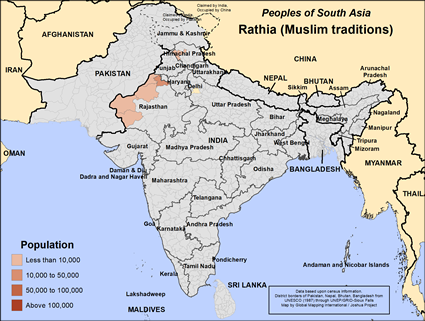The Rathia people were originally a nomadic people who lived in northwest India. At one time they were all Hindus. However, during the Mughal period some of them converted to Islam. The Rathia claim to be Rajputs or the "sons of rulers" They refer to themselves are Rajputs. Their name Rathi comes from the Rathi breed of cattle. Today the main occupation of the Rathia is still raising cattle and sheep. For part of the year they live in villages and raise crops like cotton, wheat, lentils, roots and vegetables. For another part of the year, they travel from place to place, seeking fodder for their cattle and sheep. The Indian government does not encourage the nomadic lifestyle of the Rathia. In the 1950s the Indian government determined that the Rathia do not own the land where their cattle and sheep graze.
Illiteracy is to be a problem among the Rathia. Not being able to read and write prevents them from making progress in modern Indian society.
The primary language of the Rathia is Marwari. They also speak Hindi and other regional languages so that they can communicate with other Indians who live near them.
The vast majority of Rathia live in Rajastan. A small Rathia group lives in the mountainous Indian state of Himachal Pradesh.
The lives of nomadic or semi-nomadic peoples are frequently challenging. Providing education for children of a people who travel part of the year is difficult. People who live in permanent cities and villages tend to look down on are traveling cattle breeders.
The Rathia are endogamous, that is they marry witin their group. They are not allowed to marry their sons and daughters within their particular clan or gotra.
Child marriage for the girls is common. If a wife does not have children, Rathia husbands are allowed to marry another woman. Caste councils settle legal matters such as divorce, crime and monetary disagreements.
The Rathia of Muslim tradition are not vegetarian but as Muslims they do not eat pork.
The Rathia are Sunni Muslims. Muslims follow the teachings of the Qur 'an and the prophet Muhammad. The Rathia also mix their version of Islam with folk religion. They perform rituals to ward off evil spirits who inhabit nature. Muslims believe that obeying the Five Pillars of Islam will gain them entrance into Muslim heaven when they die. They believe that Jesus or Isa was only a human prophet.
The Rathia need to hear the life-changing message about Jesus Christ. They need to see Jesus is more than human prophet. They need to realize that only through Jesus can their sins be forgiven. The Rathia need help in job training and in educating their children.
Pray for Rathia families and communities to discover and embrace the free gift of life found by trusting Christ and his finished work.
Pray for Christian workers to be effective in demonstrating how Jesus blesses and heals families and communities.
Pray that the Lord opens the hearts of the Muslim Rathia people so that Bible-believing churches might be planted among them.
Scripture Prayers for the Rathia (Muslim traditions) in India.
globalprayerdigest.org/issue/day/Hindu-Rathia-People/
globalprayerdigest.org/issue/day/Rathia-People/
en.wikipedia.org/wiki/Rath_tribe
| Profile Source: David Kugel |











